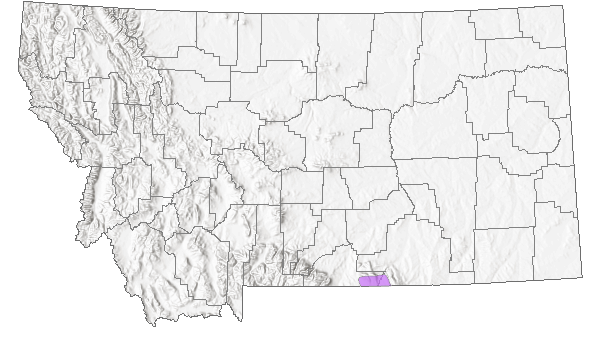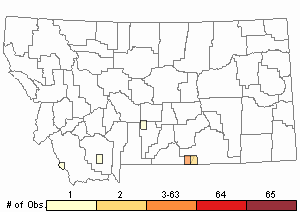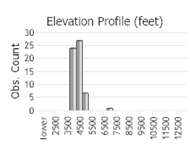View in other NatureServe Network Field Guides
NatureServe
Montana
Utah
Wyoming
Idaho
Wisconsin
British Columbia
South Carolina
Yukon
California
New York
Rough Mule's Ears - Wyethia scabra
Other Names:
Scabrethia scabra
Native Species
Global Rank:
G4
State Rank:
S3S4
(see State Rank Reason below)
C-value:
Agency Status
USFWS:
USFS:
BLM:
External Links
State Rank Reason (see State Rank above)
Wyethia scabra is found in Carbon and Bighorn Counties of Montana. Most occurrences are small due to the sparse distribution of plants on the landscape, but are frequent and widespread across the southern Pryor Mountains. Threats from grazing appear low due to the rough foliage of the leaves, and other threats have not been recognized. Most of the observation data was collected prior to 2000. More current data on population locations, sizes, and threats is needed.
- Details on Status Ranking and Review
Population Size
ScoreE - 2,500 - 10,000 individuals
Range Extent
ScoreB - 100-250 sq km (~40-100 sq mi)
Area of Occupancy
ScoreD - 6-25 4-km2 grid cells
Number of Populations
ScoreC - 21 - 80
Number of Occurrences or Percent Area with Good Viability / Ecological Integrity
ScoreC - Few (4-12) occurrences with excellent or good viability or ecological integrity
Environmental Specificity
ScoreD - Broad. Generalist or community with all key requirements common
Threats
ScoreD - Low
General Description
Stems 20–60 cm. Herbage short-hispid. Leaves: basal absent; stem leaves narrowly lanceolate, sessile or subsessile, 8–18 cm long. Involucres 15–40 mm high, hemispheric; phyllaries hispid, ciliate. Disk corollas 7-9 mm long. Rays 10 to 18, yellow; ligules 15–50 mm long. Achenes 7–9 mm long, glabrous (
Lesica et al. 2012. Manual of Montana Vascular Plants. BRIT Press. Fort Worth, TX).
Species Range
Montana Range
Range Descriptions

 Native
Native
Range Comments
MT to AZ, NM. Collected in Big Horn and Carbon counties (Lesica et al. 2012).
Observations in Montana Natural Heritage Program Database
Number of Observations: 75
(Click on the following maps and charts to see full sized version)
Map Help and Descriptions
Relative Density

Recency



 (Observations spanning multiple months or years are excluded from time charts)
(Observations spanning multiple months or years are excluded from time charts)
Habitat
Calcareous soil of juniper woodlands; valleys, montane (Lesica and Achuff 1992; Lesica et al. 2012).
Ecology
Potential and Known Pollinators:
The following animal species have been reported as pollinators of this plant species or its genus where their geographic ranges overlap:
Bombus fervidus,
Bombus melanopygus,
Bombus sylvicola,
Bombus griseocollis, and
Bombus insularis (Thorp et al. 1983, Koch et al. 2012, Williams et al. 2014).
Stewardship Responsibility
References
- Literature Cited AboveLegend:
 View Online Publication
View Online Publication Lesica, P. and P.L. Achuff. 1992. Distribution of vascular plant species of special concern and limited distribution in the Pryor Mountain desert, Carbon County, Montana. Unpublished report to the Bureau of Land Management. Montana Natural Heritage Program, Helena, MT. 105 pp.
Lesica, P. and P.L. Achuff. 1992. Distribution of vascular plant species of special concern and limited distribution in the Pryor Mountain desert, Carbon County, Montana. Unpublished report to the Bureau of Land Management. Montana Natural Heritage Program, Helena, MT. 105 pp. Lesica, P., M.T. Lavin, and P.F. Stickney. 2012. Manual of Montana Vascular Plants. Fort Worth, TX: BRIT Press. viii + 771 p.
Lesica, P., M.T. Lavin, and P.F. Stickney. 2012. Manual of Montana Vascular Plants. Fort Worth, TX: BRIT Press. viii + 771 p.
- Additional ReferencesLegend:
 View Online Publication
View Online Publication
Do you know of a citation we're missing? Lesica, P., M.T. Lavin, and P.F. Stickney. 2022. Manual of Montana Vascular Plants, Second Edition. Fort Worth, TX: BRIT Press. viii + 779 p.
Lesica, P., M.T. Lavin, and P.F. Stickney. 2022. Manual of Montana Vascular Plants, Second Edition. Fort Worth, TX: BRIT Press. viii + 779 p.
- Web Search Engines for Articles on "Rough Mule's Ears"





